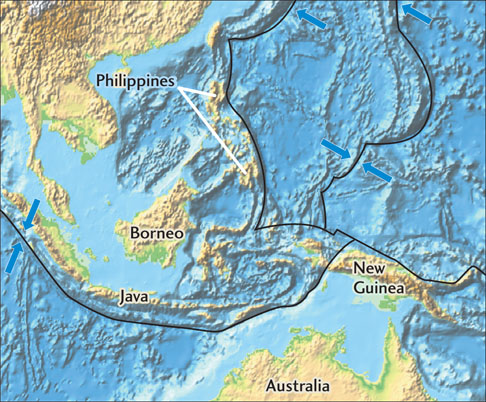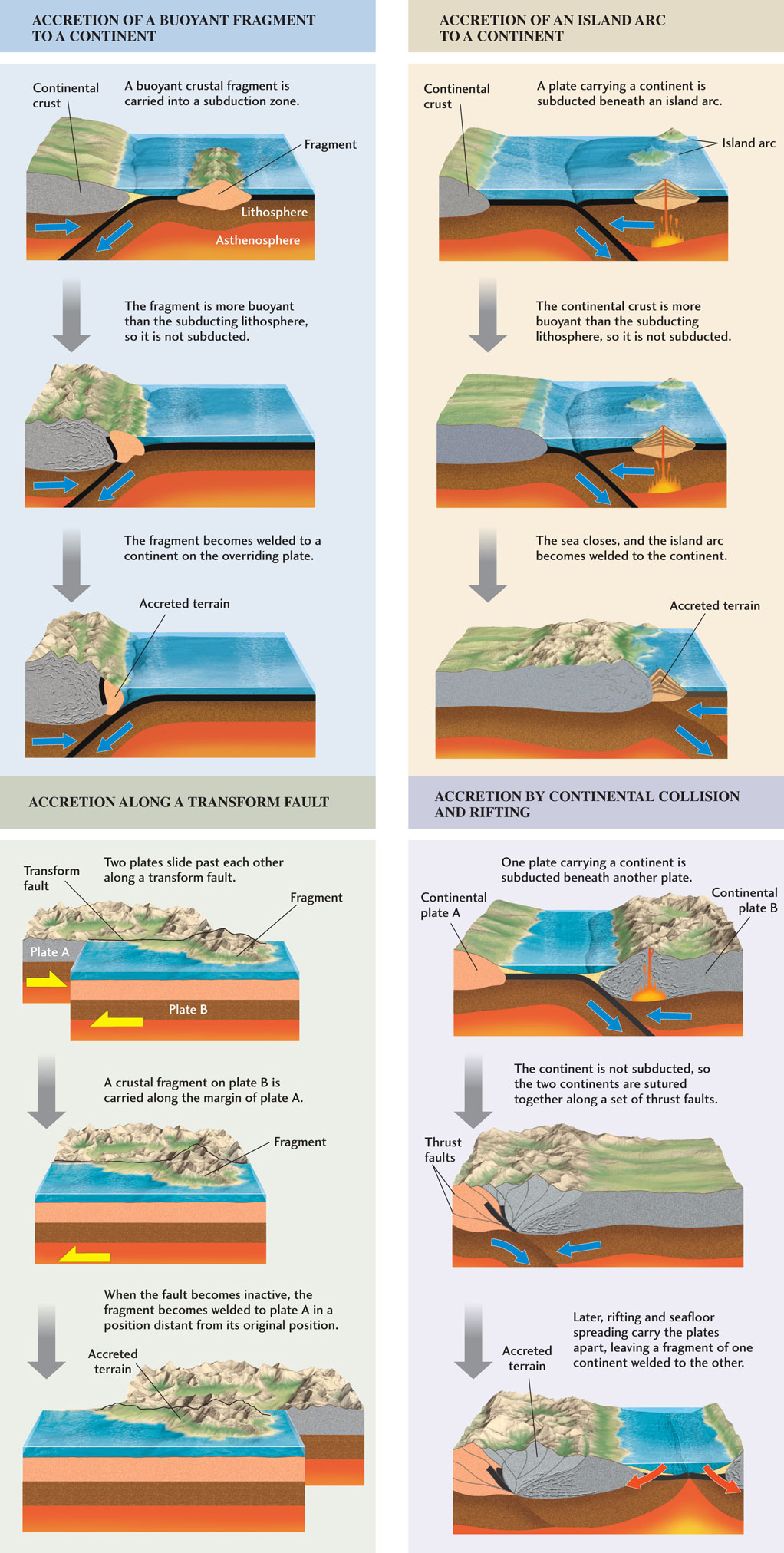How Continents Grow
Over the continents’ 4-billion-year history, new crust has been added at an average rate of about 2 km3/year. Earth scientists continue to debate whether the growth of continental crust has occurred gradually over geologic time or was concentrated early in Earth’s history. In the modern plate tectonic system, two basic processes work together to form new continental crust: magmatic addition and accretion.
Magmatic Addition
The process of magmatic differentiation of low-density, silica-rich rock in Earth’s mantle and vertical transport of this buoyant, felsic material from the mantle to the crust is called magmatic addition.
Most new continental crust is born in subduction zones from magmas formed by fluid-induced melting of the subducting lithospheric slab and the mantle wedge above the slab (see Chapter 4). These magmas, which are of basaltic to andesitic composition, migrate toward the surface, pooling in magma chambers near the base of the crust. Here they incorporate crustal materials and differentiate further to form the felsic magmas that migrate into the upper crust, forming dioritic and granodioritic plutons capped by andesitic volcanoes.
Magmatic addition can emplace new crustal material directly at active continental margins. Subduction of the Farallon Plate beneath North America during the Cretaceous period, for example, created the batholiths along the western edge of the continent, including the rocks now exposed in Baja California and the Sierra Nevada. Subduction of the remnant Juan de Fuca Plate continues to add new material to the crust in the volcanically active Cascade Range of the Pacific Northwest, just as subduction of the Nazca Plate is building up the crust in the Andes of South America.
263
Buoyant felsic crust is also produced far away from continents, in volcanic island arcs at ocean-ocean convergence zones. Over time, these island arcs can merge into thick sections of silica-rich crust, such as those found today in the Philippines and other island groups of the southwestern Pacific (Figure 10.10). Plate movements transport these fragments of crust horizontally across the globe and eventually attach them to active continental margins by accretion.

Accretion
The integration of crustal material previously differentiated from mantle material into existing continental masses by horizontal transport during plate movements is called accretion.
Geologic evidence for accretion can be found on the active margins of North America. In the Pacific Northwest and Alaska, the crust consists of a mix of odd pieces—island arcs, seamounts (extinct underwater volcanoes), and remnants of basalt plateaus, old mountain ranges, and other slivers of continental crust—that were plastered onto the leading edge of the continent as it moved across Earth’s surface. These pieces are sometimes referred to as accreted terrains. Geologists use this term to define a large piece of crust, tens to hundreds of kilometers in geographic extent, with common characteristics and a distinct origin, usually transported great distances by plate movements.
The geologic arrangement of accreted terrains can be chaotic (Figure 10.11). Adjacent blocks of crust can contrast sharply in their rock types, the nature of their folding and faulting, and their history of magmatic activity and metamorphism. Geologists often find fossils indicating that these blocks originated in different environments, and at different times, than the rocks of the surrounding area. For example, an accreted terrain comprising ophiolite suites (pieces of seafloor) that contain deep-water fossils might be surrounded by remnants of island arcs and continental fragments containing shallow-water fossils of a completely different age. The boundaries between accreted terrains are almost always faults that have undergone substantial slippage, although the nature of the faulting is often difficult to discern. Blocks of crust that seem completely out of place are called exotic terrains.

264
Before the discovery of plate tectonics, exotic terrains were a subject of fierce debate among geologists, who had difficulty coming up with reasonable explanations for their origins. Now accreted terrain analysis is a specialized field within plate tectonic research. Well over a hundred areas of the North American Cordillera have been identified as exotic terrains accreted during the last 200 million years (many more than depicted in Figure 10.11). One such terrain, called Wrangellia, originally formed as a large basalt plateau (a region of oceanic crust thickened by a large outpouring of basaltic lava) and was then transported over 5000 km from the Southern Hemisphere to its current location in Alaska and western Canada. Extensive accreted terrains have also been mapped in Japan, Southeast Asia, China, and Siberia.
265
In only a few cases do we know precisely where these accreted terrains originated. We can begin to decipher how the others came together by considering four distinct tectonic processes that can result in accretion (Figure 10.12):

- 1. A crustal fragment that is too buoyant to be subducted may be transferred from a subducting plate to a continent on the overriding plate. Such fragments can be small pieces of continental crust (“microcontinents”) or thickened sections of oceanic crust (large seamounts, basalt plateaus).
- 2. A sea that separates an island arc from a continent may be closed as the thickened island arc crust collides with and becomes attached to the advancing edge of the continent.
- 3. Two plates that slide past each other along a transform fault may result in strike-slip faulting and the movement of a crustal fragment from one plate to the other. Today, the southwestern part of California, which is attached to the Pacific Plate, is moving northwestward relative to the North American Plate along the San Andreas transform fault. Strike-slip faulting landward of the deep-sea trench in oblique subduction zones can also transport terrains hundreds of kilometers.
- 4. Two continents may collide and be sutured together, then break apart later at a different location.
The fourth process explains some of the accreted terrains found on the passive eastern margin of North America. The Appalachian fold belt contains slices of ancient Europe and Africa as well as a variety of exotic terrains. Florida’s oldest rocks and fossils are more like those in Africa than like those found in the rest of the United States, indicating that most of this peninsula was probably transported to North America when Pangaea was assembled and then left behind when North America and Africa split apart about 200 million years ago.